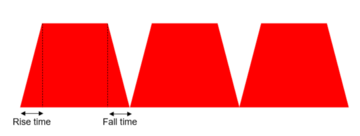"@RISE TIME (LASER)" 修訂間的差異
出自 DDCC TCAD TOOL Manual
(已建立頁面,內容為 "*Because the implementation is not perfect, there will be rise & fall time in boundaries when transmitting waveforms. Rise time set the time it takes for pulse to re...") |
|||
| (未顯示同一使用者於中間所作的 3 次修訂) | |||
| 行 1: | 行 1: | ||
*Because the implementation is not perfect, there will be rise & fall time in boundaries when transmitting waveforms. Rise time set the time it takes for pulse to reach its highest point. If [[@LASER_NUM]] is larger then one, list them separated by ",". |
*Because the implementation is not perfect, there will be rise & fall time in boundaries when transmitting waveforms. Rise time set the time it takes for pulse to reach its highest point. If [[@LASER_NUM]] is larger then one, list them separated by ",". |
||
| − | *Is store as ''' |
+ | *Is store as '''rise_time''' in the fortran code. |
example |
example |
||
| 行 6: | 行 6: | ||
100000 |
100000 |
||
| − | Which mean the |
+ | Which mean the system has one laser, and simulator will set the sending pulse's rise time as 100000(ps) make it consistent with the reality. |
| − | [[檔案:rise_fall_time.png| |
+ | [[檔案:rise_fall_time.png|360px]] |
於 2024年9月22日 (日) 16:27 的最新修訂
- Because the implementation is not perfect, there will be rise & fall time in boundaries when transmitting waveforms. Rise time set the time it takes for pulse to reach its highest point. If @LASER_NUM is larger then one, list them separated by ",".
- Is store as rise_time in the fortran code.
example
@RISE_TIME 100000
Which mean the system has one laser, and simulator will set the sending pulse's rise time as 100000(ps) make it consistent with the reality.
